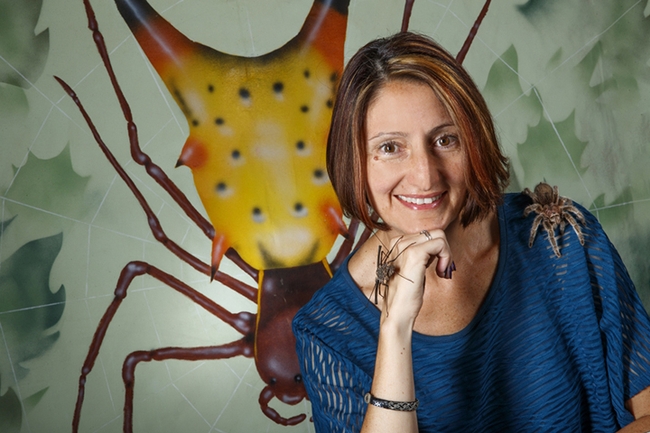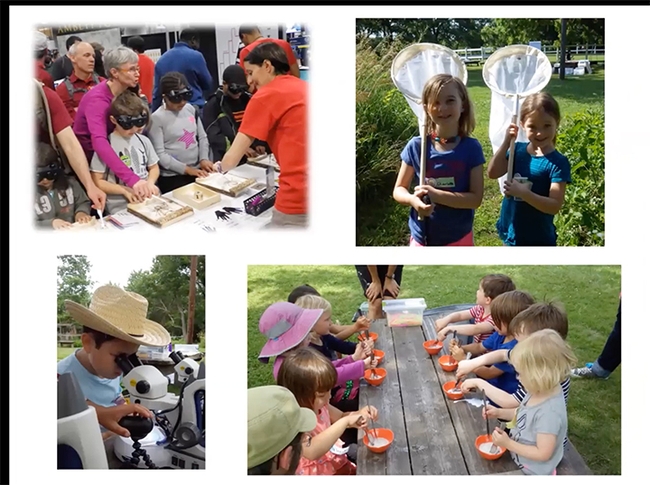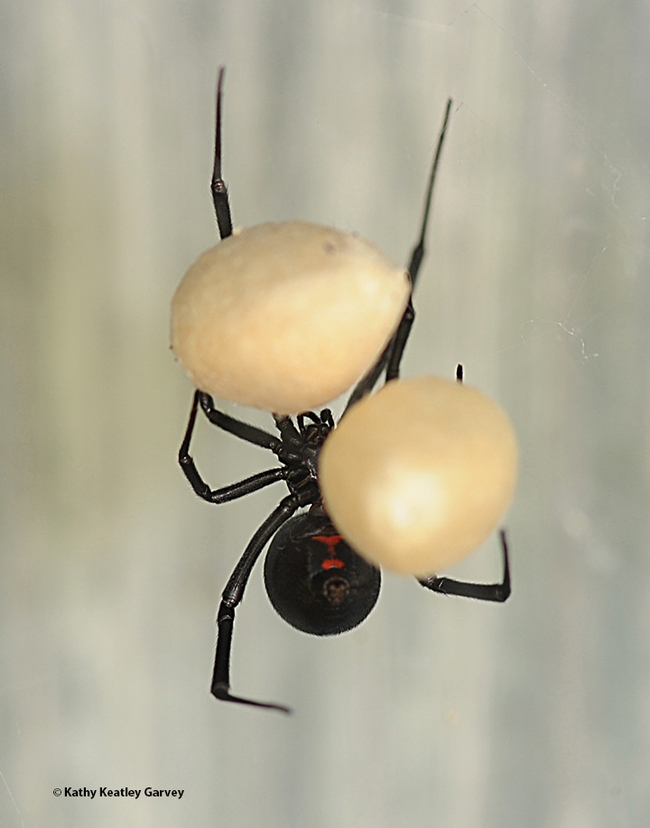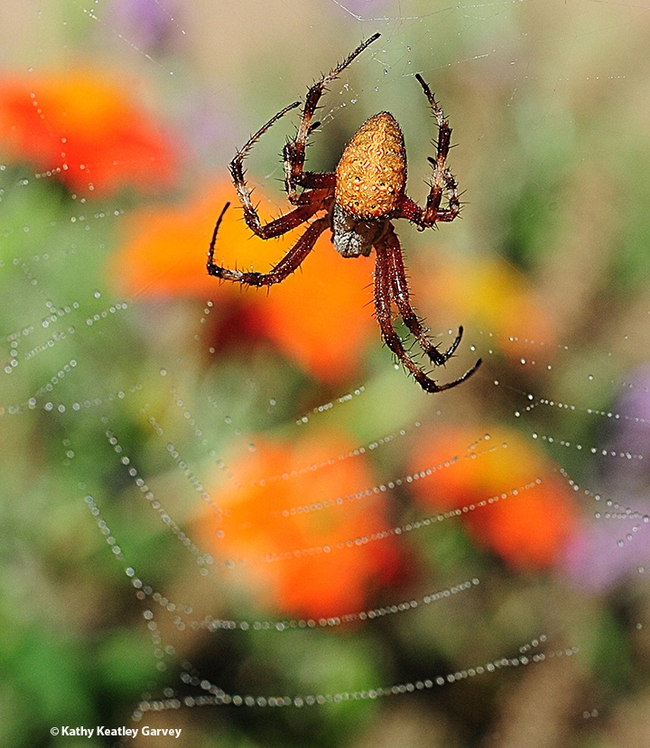- Author: Kathy Keatley Garvey
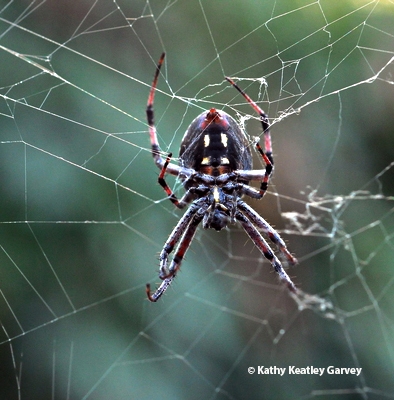
"Tens of millions of years before the orb web evolved, spiders used major ampullate silk in various forms (lampshades, tangles, sheets, funnels, etc.)," according to AAS member Eileen Hebets of the University of Nebraska, who co-hosted the open house as part of her National Science Foundation grant, "Eight-Legged Encounters," aimed at providing community outreach programs, especially for youth. "The first webs were horizontal and were not orbs. Currently, scientists believe that orb web evolved only once."
The open house kicked off the AAS meeting on the UC Davis campus. Arachnologist Jason Bond, associate dean of the UC Davis College of Agricultural and Environmental Sciences and the Evert and Marion Schlinger Endowed Chair in Insect Systematics, UC Davis Department of Entomology and Nematology, is co-chairing the June 26-30 conference.
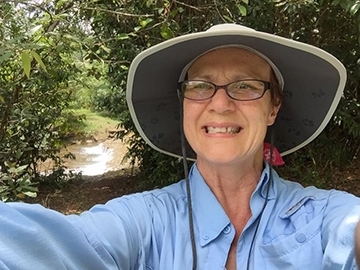
"It was about about cribellate and ecribellate silk--or sticky and not-sticky silk," said Keller, a Bohart Museum scientist who studied for her doctorate with UC Davis distinguished professor Lynn Kimsey, director of the Bohart Museum. "Some spiders produce silk and place small drops of 'sticky glue' along the silk fibers in a web and that glue traps prey when they hit the web. Other spiders produce 'fuzzy' silk, for lack of a better word, and they spin it very close together. The station was set up to have glue silk and non-glue silk."
As Hebets explains on her website:
- Cribellate silk is produced from numerous tiny silk glands underneath a specialized spinning organ called the cribellum.
- The cribellum is derived from spinnerets (the anterior median spinnerets) and its surface is covered by hundreds- thousands of tiny, elongate spigots which each produces an extremely thin single fibril of cribellate silk (~0.00001mm thick). All spigots act together to produce a single cribellate thread made up of thousands of silk fibrils. All araneomorph spiders were once cribellate, but the cribellum has been lost numerous times.
- Cribellate spiders also possess a row of toothed bristles – the calamistrum – on the metatarsal segment (2nd to last) of the last leg (4th walking leg).
- The combination of flagelliform silk threads and aggregate silk protein glue ~136 million years ago represents a major explosion in spider species numbers. Spiders that combine flagelliform and aggregate silk proteins are in the superfamily Araneoidea. In these spiders, a sticky liquid silk is carried on fibrous silk support lines.
- In summary, cribellate (wooly) and ecribellate (sticky) catching silks increase the prey holding efficiency of webs that act as snares or traps. They represent completely different evolutionary solutions to the same problem.
The procedure:
- Take a piece of pre-cut yarn.
- Pick up one piece of confetti.
- Toss the confetti at the yarn…does it stick?
- On one-half of the yarn, add droplets of glue and toss the confetti at the yarn…does it stick?
- On the other one-half of the yarn, comb it out using the eyebrow brush.
- Once the yarn is combed out, toss a piece of confetti at it…does it stick?
"It was nice to see so many folks out to an event about arachnids," Keller said. "We normally have many people out visiting the Bohart on our weekend open houses. But this was different because it focused on 8-legged invertebrates. It was such a great event getting back in person and interacting with families. It made me realize how much I have missed these outreach events and open houses where we share our passion for insects and science."
The next Bohart open house is set from 1 to 4 p.m., Saturday, July 16 and will celebrate 50 years of the California dogface butterfly (Zerene eurydice) as the state insect. The state Legislature designated the butterfly as the state insect in 1972. Keller and Bohart associate Greg Kareofelas will share their expertise on the insect. The event is free and family friendly.
The Bohart Museum, located in Room 1124 of the Academic Surge Building, houses a global collection of eight million insect specimens, plus a live "petting zoo" (Madagascar hissing cockroaches, stick insect and tarantulas) and an insect-themed gift shop.
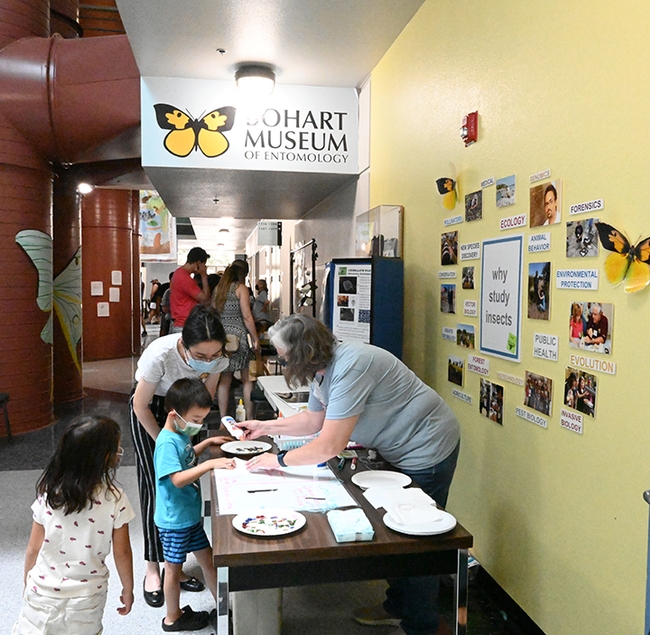
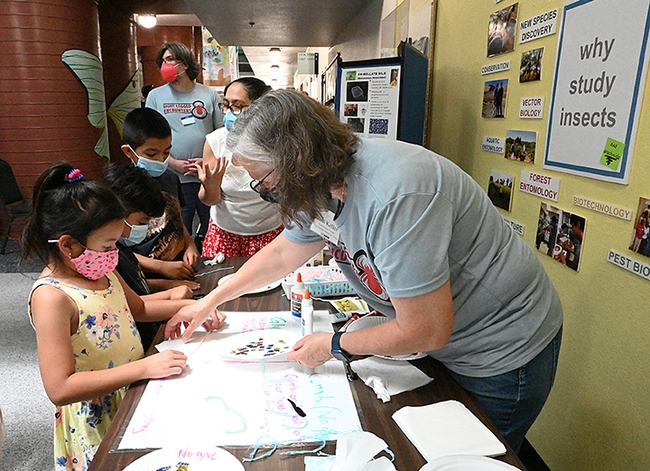
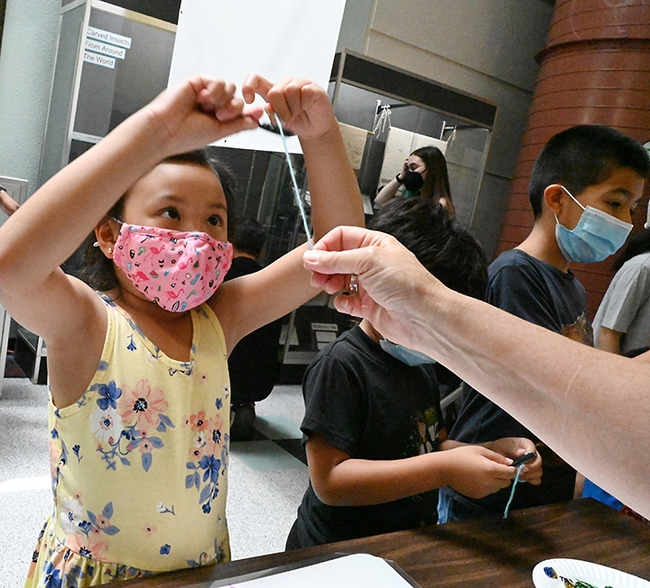

- Author: Kathy Keatley Garvey
Those who know that spiders have eight legs know exactly what's being showcased at the UC Davis Bohart Museum of Entomology open house, "Eight-Legged Encounters," on Saturday, June 25.
Spiders and other arachnids.
And you're invited.
"Eight-Legged Encounters" is a free, family friendly event where you can talk to world-renowned arachnologists who are attending the American Arachnological Society (AAS) conference at UC Davis. The open house kicks off their June 26-30 meeting.
Some 20 tables with exhibits and hands-on activities will line the hallway of Academic Surge on Crocker Lane, UC Davis campus. “There will be everything--spider specimens, live arachnids, activities, artwork, etc., at the open house," says AAS conference co-chair and arachnologist Jason Bond, associate dean, College of Agricultural and Environmental Sciences, and the Evert and Marion Schlinger Endowed Chair in Insect Systematics, UC Davis Department of Entomology and Nematology. (Listen to Jason Bond's interview on Capital Public Radio.)
Professor Eileen Hebets of the School of Biological Sciences, University of Nebraska, Lincoln, will set up the displays as part of her U.S. National Science Foundation grant, “Eight-Legged Encounters” that she developed as an outreach project to connect arachnologists with communities, especially youth.
Also at the open house, students 18 and under are invited to suggest a name for a new species of trapdoor spider in a contest coordinated by the Bond lab.
If you want encounters with butterfly, bee or beetle specimens before your eight-legged encounters, step into the Bohart Museum, located in Room 1124 of the Academic Surge Building. It houses eight million insect specimens; a live "petting zoo" (Madagascar hissing cockroaches, stick insects and tarantulas); and an insect-themed gift shop. Scientists will be on hand to guide you and answer your questions.
Folks are also looking forward to the AAS series of arachnid lectures, free and open to the public, from 7:30 to 9 p.m. Tuesday, June 28, in the newly constructed 600-seat lecture hall, California Hall.
But first, there's the Eight-Legged Encounters. Not Close Encounters of the Third Kind, but Close Encounters with the Eight-Legged Kind.
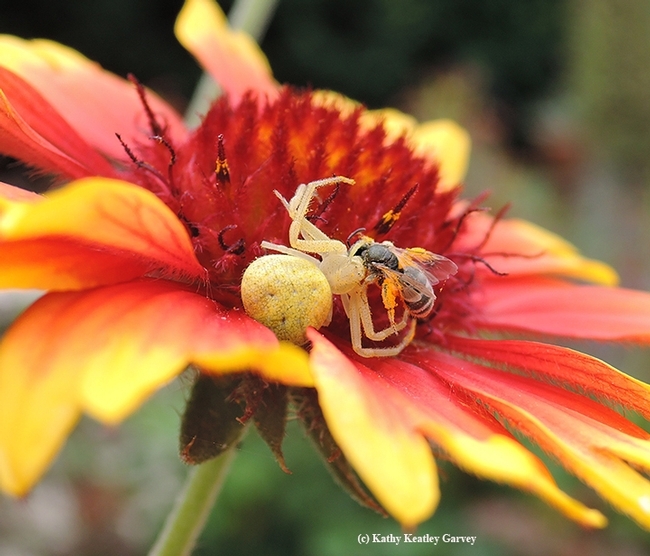
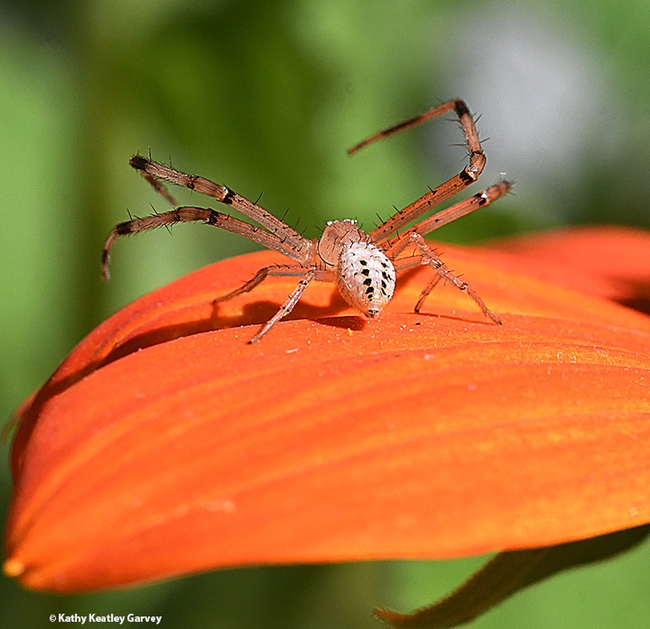
- Author: Kathy Keatley Garvey
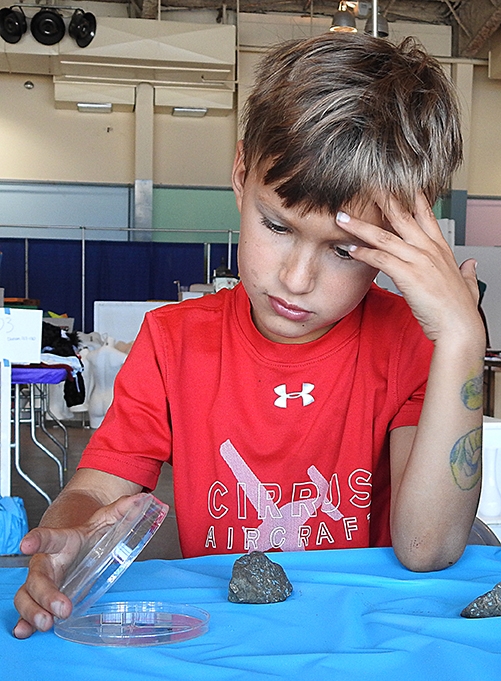
When you first meet Brandon DeGroot, 6, of Vallejo, he'll tell you "I love spiders and snakes" and he'll flash a big smile.
He's the kind of youngster that arachnologists, including Professor Eileen Hebets of the University of Nebraska and Professor Jason Bond, of the University of California, Davis, welcome to their fold.
Bond, associate dean of the College of Agricultural and Environmental Sciences, and the Evert and Marion Schlinger Endowed Chair in Insect Systematics, UC Davis Department of Entomology and Nematology, is chairing the American Arachnological Society's meeting June 26-30 at UC Davis with Lisa Chamberland, postdoctoral research associate, Department of Entomology and Nematology, and Joel Ledford, assistant professor of teaching, Department of Plant Biology, College of Biological Sciences.
An open house, "Eight-Legged Encounters," set from 1 to 4 p.m., Saturday, June 25 at the Bohart Museum of Entomology, will kick off the conference. Hebets is co-hosting it as part of a U.S. National Science Foundation grant, “Eight-Legged Encounters,” that she developed as an outreach project to connect arachnologists with communities, especially youth. It's free, open to the public, and family friendly.
The open house promises to be one of the biggest events--if not the leggiest!--of the year on the UC Davis campus and beyond. A powerhouse of arachnologists, Bond said, will be at the open house. “There will be everything--spider specimens, live arachnids, activities, artwork, etc."
Some 20 exhibits and activities will be set up in the hallway of the Academic Surge Building, said Tabatha Yang, the Bohart Museum's education and outreach coordinator. A popular activity at the Bohart is its live petting zoo, comprised of Madagascar hissing cockroaches or "hissers," stick insects and tarantulas. Youths, especially, delight in holding the hissers and stick insects.
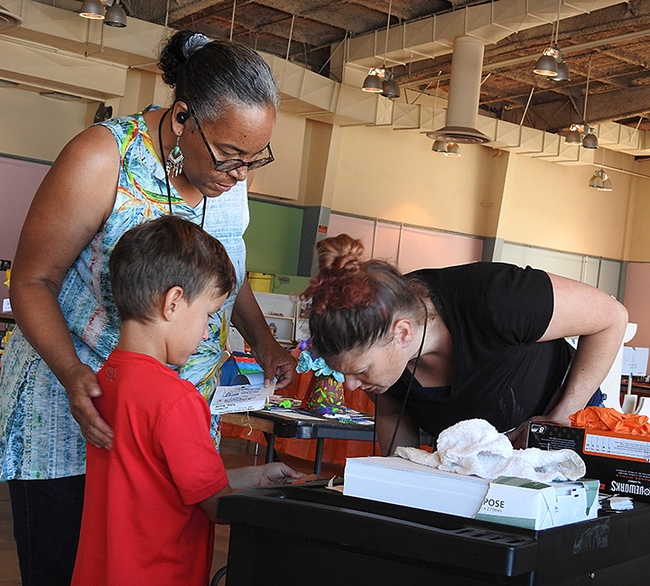
But back to Brandon.
"Brandon has always loved spiders, insects and snakes, starting when he was a toddler looking for bugs in our yard," said his mother, Heather DeGroot. "Brandon was always in the dirt, and my other son, Mason, now 8, was always in the grass." Last Tuesday, June 7, while Heather kept busy coordinating the Solano County Fair exhibits at McCormack Hall, in preparation for the June 16-19 fair, Brandon kept busy looking for critters outside. When he'd find one, he'd excitedly announce his treasure, and even more excitedly, show it to all.
So, in between his bug hunts, we thought we'd interview Brandon.
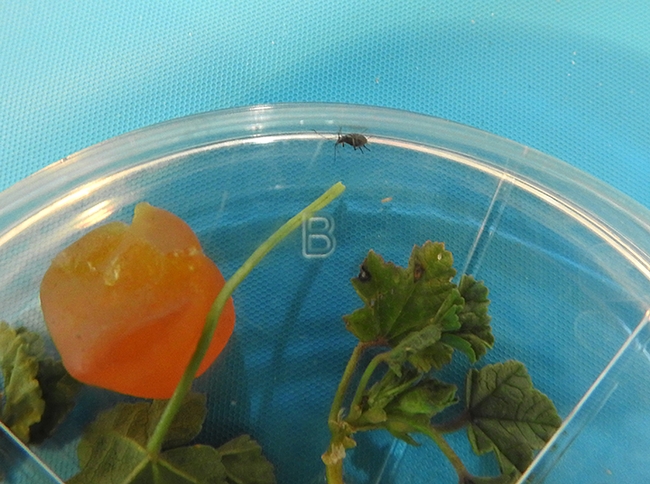
Brandon: "Brandon."
Bug Squad: "How old are you?
Brandon: "I'm six and I go to kindergarten at Vallejo Charter School. I'm almost in the first grade." (He graduated from kindergarten June 9.)
Bug Squad: "Brandon, how long have you loved spiders and snakes?"
Brandon: "A long time."
Bug Squad: "Cool! Why do you love spiders?"
Brandon: "I like the poison and how they eat."
Bug Squad: "What do you want to be when you grow up, Brandon?"
Brandon: "I want to be a scientist about animals. See my snake tattoo on my arm?" (He displayed the washable tattoo that tattoo artist Jason Meyers of Concord created just for him.)
Bug Squad: "Fantastic! What makes you happy?"
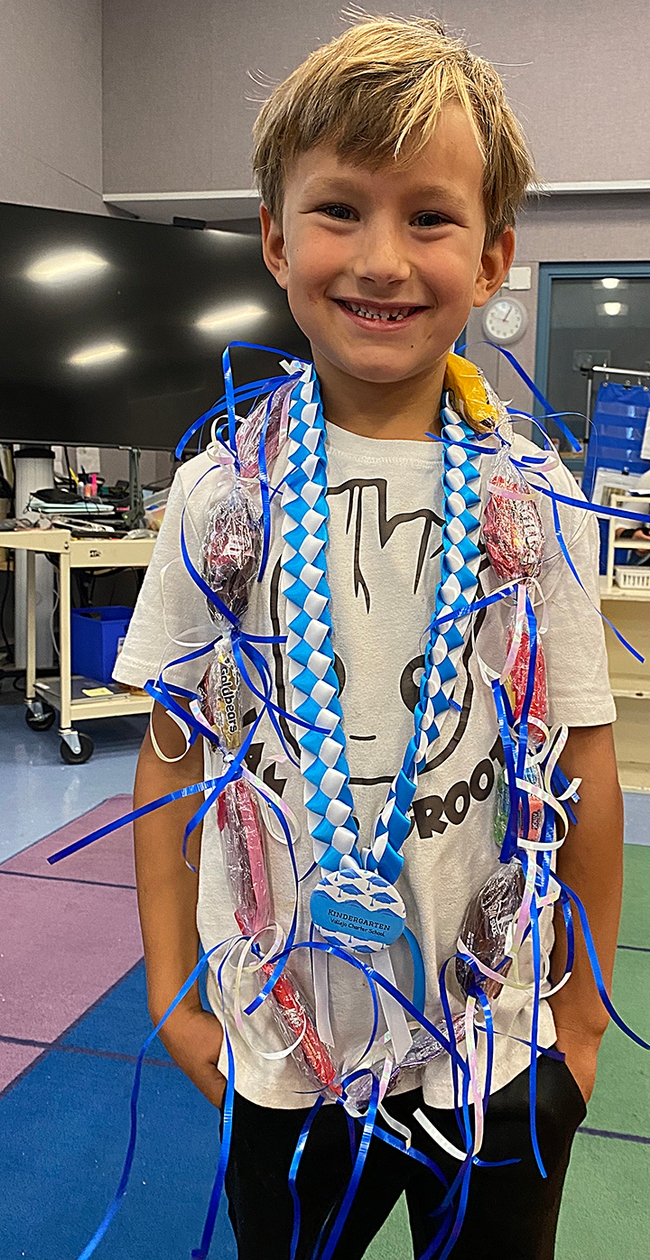
Bug Squad: "Does your brother Mason like snakes and spiders?"
Brandon: "No, he only likes BMX." (Mason will be competing as part of Team USA at a BMX competition in Nance, France in July. The entire family will be there to support him.)
Bug Squad: "Why doesn't Mason like spiders and snakes?"
Brandon: "He doesn't want to get hurt by them."
Bug Squad: "Do you like bees?"
Brandon: "I like bees. They pollinate the flowers and make them change colors. I like ladybugs and I like letting them crawl on me. I like walking sticks. I saw them on YouTube and they look just like sticks."
Bug Squad: "Do you like ants?"
Brandon: "I like ants but I don't like fire ants." (He sees fire ants on family trips to Houston, Texas.)
Bug Squad: "Do you like butterflies?"
Brandon: "I like them because of their colors."
Bug Squad: "Do you like dragonflies?"
Brandon: "I like how fast they fly and they nibbled on my family at the Yuba River but they didn't nibble on me."
Bug Squad: "Brandon, do you like sports or play sports?"
Brandon: "I played basketball and I'm going to learn to play tennis."
Bug Squad: "Do you like girls?"
Brandon (raising his eyebrows): "No, I like dogs."
Bug Squad: "Do you have a dog?"
Brandon: "No."
Bug Squad: What's your favorite food?"
Brandon: "Strawberries and chocolate."
And with that, he opened his lunch box, picked out a strawberry, and shared it with a bug that he had just collected in the McCormack Hall gardens.
"Here you go," Brandon told the bug, later identified by Lynn Kimsey, director of the Bohart Museum of Entomology, UC Davis, as an aphid. "I'm feeding you so you won't get hungry."
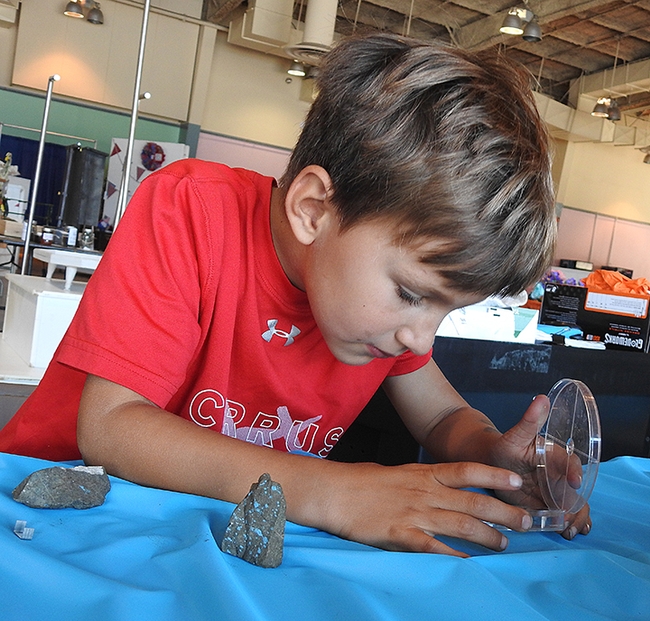
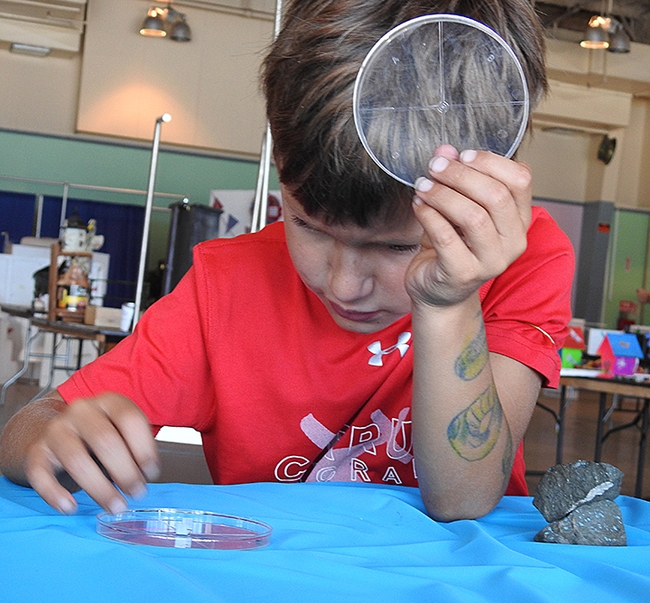
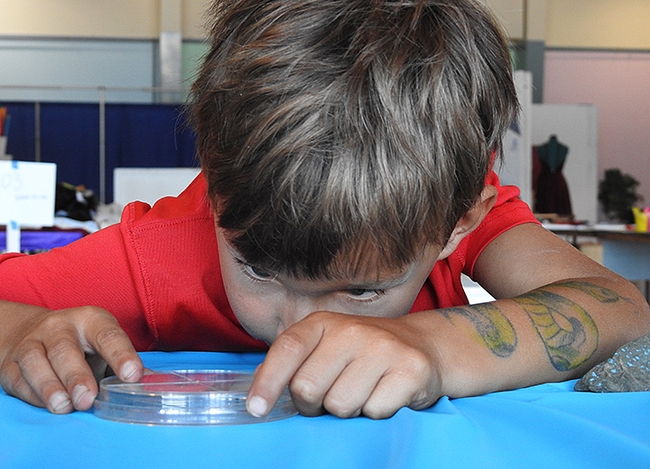
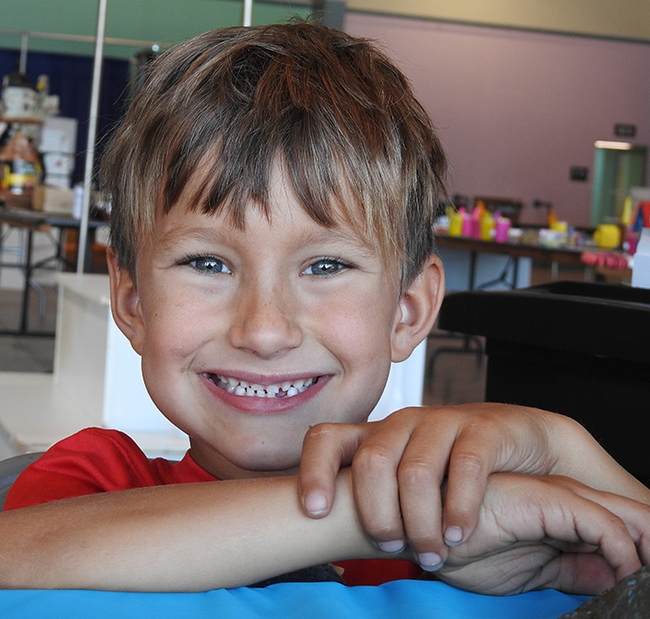
- Author: Kathy Keatley Garvey
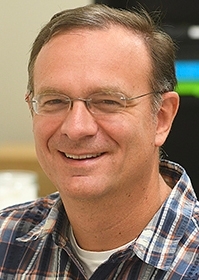
A free, public open house on “Eight-Legged Encounters,” featuring spiders and other arachnids, promises to be one of the biggest events--if not the leggiest!--of the year on the UC Davis campus and beyond.
The event, set from 1 to 4 p.m., Saturday, June 25 in the Bohart Museum of Entomology, Academic Surge Building, Crocker Lane, will officially kick off the 2022 American Arachnological
A "powerhouse" of arachnologists will be participating, said Jason Bond, associate dean, College of Agricultural and Environmental Sciences, and the Evert and Marion Schlinger Endowed Chair in Insect Systematics, UC Davis Department of Entomology and Nematology. He will be hosting the conference with Lisa Chamberland, postdoctoral research associate, Department of Entomology and Nematology, and Joel Ledford, assistant professor of teaching, Department of Plant Biology, College of Biological Sciences.
“There will be everything--spider specimens, live arachnids, activities, artwork, etc.," Professor Bond said.
Some 20 exhibits and activities will be set up in the hallway of the Academic Surge Building, said Tabatha Yang, the Bohart Museum's education and outreach coordinator.
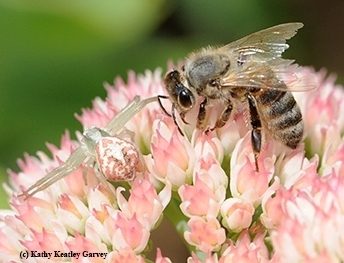
Through the NSF grant, awarded in 2013, Hebets seeks to educate the public “about the wonders of biology and the possibility of scientific discovery using a charismatic and engaging group of animals--arachnids. Arachnids (spiders and their relatives) are ubiquitous, thriving in most habitable environments on our planet (including underwater),” Professor Hebets writes on her website at https://hebetslab.unl.edu/
“As a scientist, a mother, and an educator, I often see the disconnect between youth and the world around them; between problem solving skills, observation skills, critical thinking, natural curiosity and the more traditional formal teaching programs experienced by many students,” she writes. “Youth are innately curious and tremendously creative and my aim is to leverage these traits for their own educational advancements in a fun and engaging manner.”
To date, Hebets and her collaborators have developed more than 25 modular activity stations “encompassing arts and crafts, experiments, games, and other hands-on activities." They include classification and taxonomy, spiders and silk, path of predators, and hands-on science.
Also at the open house, plans call for “A Name that Spider" event, coordinated by postdoctoral fellow Lisa Chamberland and PhD students Iris Bright and Emma Jochim of the Bond lab. “We'll have an exhibit at the event with details on the spider,” Bond said. “We'd like to restrict naming suggestions to be youths attending the event, students 18 years and younger."
Another highlight of the American Arachnological
